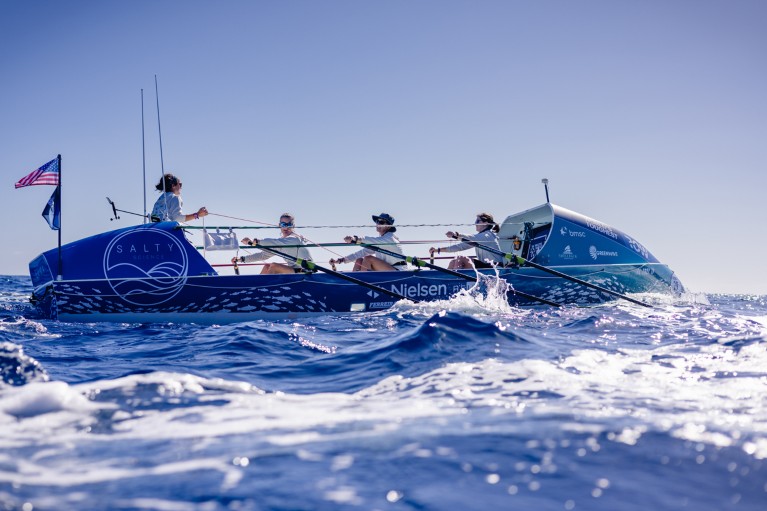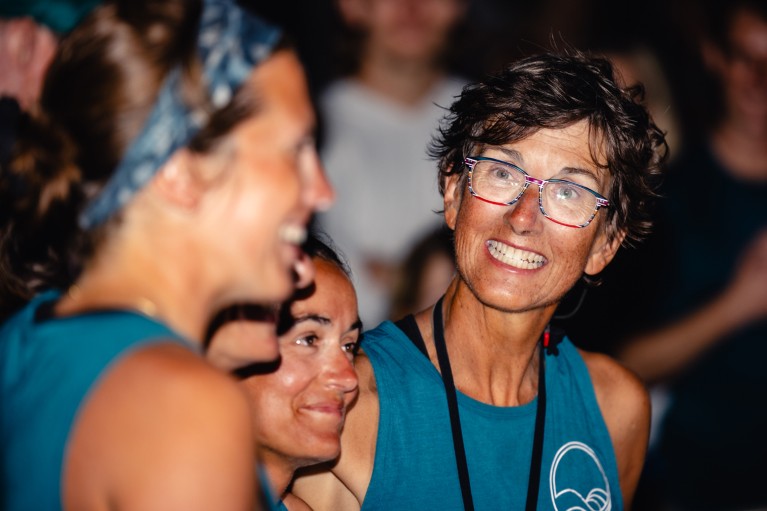
Marine ecologist Isabelle Côté (second from left) and the Salty Science team light flares as they cross the finish line at the island of Antigua, winning the women’s division of the World’s Toughest Row competition.Credit: World’s Toughest Row
Isabelle Côté is not one to shirk a physical challenge. So when a former graduate student asked her to join a team rowing across the Atlantic Ocean to raise funds for charities supporting marine conservation, education and science, she responded with an emphatic yes.
A marine ecologist at Simon Fraser University (SFU) in Burnaby, Canada, who studies coral reefs, Côté and her teammates spent three years planning and preparing mentally, physically and logistically for the World’s Toughest Row, a 4,800-kilometre crossing from Spain’s Canary Islands, off the coast of northwestern Africa, to the eastern Caribbean island of Antigua, in Antigua and Barbuda. When the race began, it was a challenging departure into the unknown. But on 20 January this year, after 38 days, 18 hours and 56 minutes, the aptly named Salty Science team rowed across the finish line, clinching first place in the women’s division and seventh overall in the race.
Côté was enlisted by her former doctoral student Chantale Bégin, a marine biologist at the University of South Florida in Tampa. While on sabbatical in Antigua doing field work, and living on a sailing boat with her husband and young children, Bégin had watched the finish of the 2018 race. “This is insane,” she remembers thinking. Her former undergraduate student, Lauren Shea, working in Antigua for Seamester, a study-at-sea programme, saw the 2020 and 2021 finishes and vowed to do the race herself one day. Shea reached out to Bégin and Noelle Helder, a marine scientist at the University of Alaska Fairbanks, whom she had befriended in one of Bégin’s marine ecology courses, to see whether they’d be interested, too, and they said yes straight away.
The trio wanted to recruit another female marine scientist. Bégin hadn’t spoken to Côté for years, but knew the 61-year-old was a canoeist and kayaker, ultra-marathon runner and long-distance swimmer. “I knew she had the endurance,” says Bégin. With Côté’s thumbs-up, the team became four.
Early enthusiasm was the easy part. The hard work came next.
Preparation, perspiration, trepidation
For the first year of planning and preparation, Côté was swamped with work, being the chair of Simon Fraser University’s biology department. So Helder and Bégin laid the foundation, finding a boat, researching what gear and training they would need and setting up a team website and social-media accounts. In the World’s Toughest Row, teams compete to navigate and row an unpowered 8.5-metre rowing boat, unsupported, across the Atlantic. Race entry is expensive, as is buying a purpose-built, high-tech boat that is seaworthy and fully kitted out. So most teams fundraise, not only to cover race expenses but also for a cause.
From the beginning, “it was pretty clear to us that the ocean was going to be our cause”, says Côté, noting that the whole team works on, under or around the ocean, and also spends a lot of recreation time there. Bégin and Shea were accomplished sailors, but none of the team members rowed. They also had to master technology and navigational tools, and hone their physical and mental stamina.

The Salty Science team of four marine scientists sets out from La Gomera in Spain’s Canary Islands at the beginning of the race.Credit: World’s Toughest Row
With the team of four representing three academic generations, “Isabelle was like the academic grandma of the younger two”, says Bégin, who was conscious that the hierarchical history could become “a weird thing”. From the beginning, they were consciously collaborative; each had delegated roles. Côté’s was emergency first aid.
The team set three goals, in priority order: to finish safely, to remain friends throughout and to row as fast as they could, explains Shea. “If we needed to stop rowing to have a team chat or go for a swim together, even though that wasn’t the fastest option, that’s what we’d do.”
Geographically separated for the introductory training phase, each learnt to row independently. “Classical rowing in narrow boats teaches you technique, but ocean rowing is a different beast altogether,” says Côté. “The only way to get good at ocean rowing is to row on the ocean.”
Performance coach and former rower Cady Hart-Petterssen, based in Plainfield, Vermont, designed their fitness regime. It was a meticulous plan, including training through periods of sleep deprivation, something they would face while rowing shifts of three hours on, three hours off, around the clock.
To build psychological resilience and effective team dynamics, they hired sports psychology consultant Terri Schneider, based in Santa Cruz, California, who designed individual and team-building exercises. A big focus, Schneider explains, was on coping mechanisms for staying functional in the face of fear, stress, exhaustion and physical discomfort. And — when not battered by seasickness — they did.
Perseverance in rough seas
The first ten days after departing from La Gomera in the Canary islands were rough. The 10-metre waves were bigger than their boat, which at times seemed to be almost vertical. “It was just terrifying,” says Côté. “I thought I was gonna die several times.”
Then the wind died. “The damn trade winds didn’t come,” or blew in the wrong direction. “We called those the rowing-in-cement days,” says Côté, in reference to how difficult it was to make progress. After riding massive waves during the first week and a half, and reaching a peak speed of more than 17 knots (31.5 kilometres per hour), they slowed down at times, during their cement days, to only 1 or 2 knots.
Côté knew from doing ultra-marathons — runs of 50 kilometres or more that had taken her 8–10 hours — that she often started and finished strong, with a low point in the middle.

Isabelle Côté with a look of disbelief once back on land after 38 days, 18 hours and 56 minutes of rowing across the Atlantic ocean.Credit: World’s Toughest Row
“I’ve suffered from mild depression my entire life,” says Côté. And during the race, “I really struggled with it. It hit me right in the middle. But I was in this situation, unlike other big events I’ve done, where I could not quit. Nobody was going to come and take me off that boat. And the only thing I could do to get myself out of there was to row. So that’s what I did.
“I’m proud of the fact that despite rowing under a black cloud, I gave 100% every shift,” says Côté.
The small team, rowing its tiny boat across a vast, unforgiving ocean, was cheered on by a big team of supporters. Côté’s former doctoral student Nicola Smith, a marine ecologist at Concordia University in Montreal, Canada, was one of many sponsors following their progress virtually. “I wanted to be a small part of her big dream,” says Smith. Despite being a lot older than her teammates, Côté “can work equally as hard and still accomplish great things”, says Smith. “She has shown me that dreams don’t have an expiration date.”
Reflecting on the epic experience, Côté said that the journey had reinforced (with a hefty dose of fear) her enormous respect for the ocean and its incredible beauty. Nevertheless, “it made me realize I love the coast”, she laughs.
One big take-way for Côté is that “I have the mental and physical fortitude to take on really big challenges”, she says. “I still don’t consider myself an extraordinary person,” she adds, but “ordinary people can do extraordinary things.”

